Articles
There are many metaphors about using propitious moments to prepare for an inclement future: make hay while the sun shines, the best time to fix the roof is on a clear day, strike while the iron is hot, etc. These all imply the drudgery of work: a farmer baling hay on a sunny day, a slater shingling high on a roof under a blue sky, a forger hammering inside a sweltering workshop on a breezy afternoon. In a third semester continuation of the rest of a tense, yet stable 2023, there is a sense in which both South Korea and North Korea have been following the lesson of these proverbs as they use relative calm on the Korean Peninsula to build out their respective, opposed security and defense capabilities. Another, similar proverb captures an additional element of this dynamic: if you spend your whole life waiting for the storm, you’ll never enjoy the sunshine. Despite the tension on the Korean Peninsula, leaders in both Seoul and Pyongyang appear confident, even buoyant about their security and defense buildups.
The US, as the senior partner in the US-South Korea alliance and primary antagonist for North Korea, usually focuses on the grim dynamic on the Korean Peninsula, but both South Korean President Yoon Suk Yeol and North Korean leader Kim Jong Un are seemingly enjoying the moments of opportunity to prepare for the coming storm, both in the sense of taking advantage of defense preparation possibilities afforded by relative calm, and in the sense of using them for domestic political benefit.
Yoon’s belief in peace-through-strength, increasing domestic military capabilities, and swaggering alliance relations with the US is his primary source of political capital, given that the National Assembly is held by an opposition majority blocking most of his domestic initiatives. Foreign, defense, and security policy are even more crucial for Yoon as 2024 marks legislative general elections. If Yoon’s People Power Party fails to win a majority, then he will spend his entire presidency with a hostile National Assembly actively undermining his domestic priorities. For Kim Jong Un’s part, North Korea’s rapidly growing military capabilities (including solid-fuel ICBM and military reconnaissance satellite successes) are developing in a favorable international context: the Russia-Ukraine war has led to upgraded Moscow-Pyongyang economic and military relations, great power competition with the US continues to incentivize Chinese economic and diplomatic support for North Korea, and the Israel-Hamas war distracts world attention from malign North Korean behavior. All this aids Kim with his most fundamental interest—maintaining a domestic system that will keep him and his family in power in perpetuity.
There is another, less sanguine interpretation of the current dynamic on the Korean Peninsula: South and North Korea are using current stability to drive forward a security dilemma, notably via an arms race likely to result in crisis. This is in no one’s interest, but that is precisely the tragedy of security dilemmas. For its part, the US may understand the grim dynamic on the Korean Peninsula, but its diplomatic options for off-ramps are precluded by the behavior and nature of the Kim regime, and so Washington has moved forward with a robust development of US-South Korea allied deterrence vis-à-vis North Korea. Hence the security dilemma spiral takes yet another turn toward a stormy reckoning.
US-South Korea Relations: Shelter from the (Oncoming) Storm
The first two reporting periods of 2023 in US-South Korea relations were marked by historic events: (a) the May Biden-Yoon summit in Washington celebrating the 70th year of the alliance and deepening it via the Washington Declaration, which both modernized US extended deterrence for South Korea and expanded the alliance’s scope; (b) the trilateral US-South Korea-Japan summit at Camp David in August, in which the three states formed a sort of quasi-trilateral alliance featuring a shared “commitment to consult” in case of crisis and the institution of regular joint military exercises and cooperation, inter alia. Much of the last four months of 2023 in US-South Korea relations was dedicated to transforming the alliance’s recent commitments into concrete action.
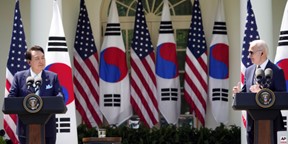
Figure 1 President Yoon Suk Yeol of the Republic of Korea and President Joseph R. Biden Jr. of the United States met in Washington to commemorate the 70th anniversary of the U.S.-ROK Alliance. Photo: U.S. Mission Korea
In this regard, military exercises are the most visible deliverable. In September, the US and South Korea held combined naval drills, which had added urgency as they took place within the context of North Korean threats following a Russia-North Korea leader summit, as well as the earlier unveiling of a North Korean tactical nuclear-armed submarine (see the US-North Korea section). This was followed in October by US-South Korea anti-submarine exercises with advanced naval assets—part of a larger set of major combined maritime exercises—and the first-ever landing of a US nuclear-capable B-52 on South Korean territory. November continued the elevated rhythm of Washington-Seoul military exercises, as combined air drills integrated B-52s with other assets around the Korean Peninsula. Also in November—shortly after North Korea apparently successfully placed a rudimentary military reconnaissance satellite in space—the US engaged in a show of force highlighting integrated deterrence assets with a port call of the USS Carl Vinson accompanied to the region by its carrier strike group, including a nuclear-powered attack submarine that docked at the Jeju-do naval base. Finally, the US and South Korea carried out combined air maneuvers featuring a B-1B Lancer strategic (non-nuclear) bomber in mid-December as a response Pyongyang’s launch of a HWASONG-18 solid-fuel ICBM, and followed that with live-fire army maneuvers including K1 tank and Stryker brigades to end the year (even spilling over into the first week of January 2024).
Following the direction of the Washington Declaration in May, all these exercises were in addition to the normal cycle of US-South Korea combined training, which typically leads to a dyspeptic North Korean response. Indeed, the additional third trimester exercises to buttress deterrence on the Korean Peninsula gave Pyongyang the occasion to riposte with the normal fiery rhetoric threatening crisis and annihilation of the Kim regime’s adversaries. What was out of the norm was the degree to which US-South Korea military drills were augmented by trilateral US-South Korea-Japan military exercises (some of which were add-ons to the US-South Korea bilateral maneuvers). This effort—a programmatic realization of the intent outlined at the Camp David summit in August—began in early October with US-South Korea-Japan naval exercises for interdicting North Korean illicit maritime activity. Late October raised the stakes with the first ever US-South Korea-Japan joint air exercise held near the Korean Peninsula. Late November saw a third round of trilateral exercises—these once more naval in nature and including the Carl Vinson—in the wake of Pyongyang’s satellite launch vehicle (SLV) and placing of a military reconnaissance satellite in orbit (see US-North Korea section).
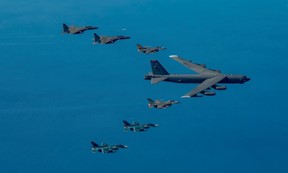
Figure 2 On October 22, 2023, fighter aircraft from the U.S., Japan, and the Republic of Korea conducted a trilateral escort flight accompanying a U.S. B-52H Stratofortress Bomber operating in the Indo-Pacific. Photo: U.S. Indo-Pacific Command Public Affairs
Trilateral military training is the tip of the iceberg in terms of augmenting deterrence against North Korean plans and capabilities. US-South Korea-Japan military cooperation is also evolving rapidly in the intelligence space. On Oct. 17 Washington, Seoul, and Tokyo announced the establishment of a trilateral communication hotline to deal with North Korean threats and Chinese regional assertiveness. Then in November the three states shared information on North Korea’s SLV. Finally, and potentially most importantly in the medium-term, the US, South Korea, and Japan have taken the first steps for real-time sharing of sensoring data on North Korean missiles. This was already announced earlier in 2023, and reiterated in November, before finally reaching operational status in December. Washington and Seoul reported the operation of the trilateral real-time missile data sharing on Dec. 19, one day after North Korea successfully fired a solid-fuel HWASONG-18 ICBM. It is unclear if this data sharing network was utilized to track the December ICBM launch, but North Korea should worry that such shared tracking capability could, over time, lead to trilateral missile defense cooperation that would better shelter the three allies from North Korean attack, degrading the strategic value of Pyongyang’s nuclear arsenal.
The operational military level is only one part of alliance deterrence vis-à-vis North Korea—strategy and diplomacy are also crucial elements. Washington and Seoul naturally emphasized these alliance activities throughout the last part of 2023 as they built on the renewed foundations laid at the Washington and Camp David summits. Leader-level engagement to this end was noteworthy, with Biden and Yoon meeting on multiple occasions during the September-December period, including at the September G20 and United Nations General Assembly (UNGA) meetings, as well as in November at the Asia-Pacific Economic Cooperation (APEC) Leaders Meeting in San Francisco.
One level down, at the senior official rank, US Secretary of State Antony Blinken visited Seoul in November for talks with his counterpart, Park Jin, on US-South Korea cooperation on handling North Korea (especially in the context of greater Moscow-Pyongyang cooperation), the Russia-Ukraine war, the Israel-Hamas conflict, and other issues. US National Security Advisor Jake Sullivan traveled to Seoul for discussions in early December, as did (with no publicity) CIA Director William Burns. The most substantive of high-level US-South Korea alliance maintenance activities during the third trimester of 2023 were the meetings of US and South Korean defense ministers and joint chiefs of staff. Already in September the allies were signaling significant updates to their joint deterrence strategy, and this came to fruition in November with the annual Security Consultative Meeting (between defense ministers) and Military Committee Meeting (between joint chiefs of staff). The readouts of these meetings mention an updated tailored deterrence strategy and a new alliance “Defense Vision.” At the level of deputy national security advisor, the US and South Korea continued to develop the Nuclear Consultative Group (NCG), established as part of the Washington Declaration to get more buy-in and input from South Korea regarding US extended nuclear strategy for the Korean Peninsula. If the schedule holds up, the US and South Korea will establish guidelines for the planning and operation of a shared nuclear deterrence strategy by mid-2024. This NCG output was in addition to ongoing, regular meetings of the Extended Deterrence Strategy and Consultation and Group at the assistant secretary/deputy minister level.
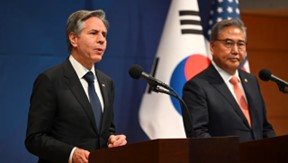
Figure 3 U.S. Secretary of State Antony Blinken, accompanied by South Korean Foreign Minister Park Jin, addresses the media during a joint news conference at the foreign ministry in Seoul on Thursday, November 9, 2023. Photo: Jung Yeon-je/Pool Photo via AP
More prosaically, US officials approved a raft of military equipment procurement agreements and plans, including South Korean purchases of additional F-35 fighter aircraft (and related equipment) and SM-6 interceptors, joint military use of 5G, and prioritization of coordination on production of defense goods/equipment. Following Pyongyang’s SLV launch, Seoul’s partial suspension of the Comprehensive Military Agreement (CMA) providing stability along the military demarcation line met with approval from Washington, which qualified the response as “prudent” and “restrained” in light of North Korea’s advancing capabilities.
Beyond deterrence, warfighting, and military cooperation, alliance maintenance in other areas also gained in importance during the September-December period, as Washington-Seoul relations grew in comprehensiveness along with both the commitments of the Washington Declaration and greater global/regional political disorder. In addition to discussion at the leader and ministerial levels, US and South Korean lower-ranking senior officials crisscrossed the Pacific Ocean to discuss economics/trade and supply chains, protection of cutting-edge technology, the Russia-Ukraine and Israel-Hamas wars, emerging issues such as cyber and space, and global challenges like human rights, climate change, and HADR.
Arguably the two most significant topics among this list are the Russia-Ukraine war and the confluence of trade/economics and high-technology. Regarding the former, North Korea’s apparently massive delivery of ammunition and artillery (shells and rockets) to Russia resulted in (likely) significant Russian assistance to North Korea, including possibly in know-how and technology supporting the Kim regime’s military satellite program. For its part, South Korea has become a major supplier of artillery shells to Ukraine (albeit via indirect pathways). As for the latter issue, Washington and Seoul worked at various official levels to overcome confusion and unease on economics/trade and technology, notably through coordinating on IPEF, clarifying rules-of-origin for critical components of technology potentially qualifying for IRA subsidies, and reaching an understanding on rules for technology transfers to China while providing South Korean high-tech industry predictability going forward and time to adjust its business model.
That said, the overlap of international trade, supply chains, and rules-based order within the context of US-China great power competition continues to produce friction between the US and South Korea. Washington’s “de-risking” strategy vis-à-vis Beijing is spilling over as an imperative to allies and partners—such as South Korea—who have both a different trade profile with China and different assessments of the relative risks of growing or curtailing trade with China in sensitive areas (e.g., semiconductors, batteries, high-tech minerals). And there is some frustration that the US’s “small garden, high wall” masks problematic protectionism of US industry. Put differently, when South Korea’s incoming trade minister Cheong In-kyo pledged to address supply chain risks for certain technology goods, it is hard to avoid reckoning that, in addition to China, the US also falls into the risk column.
The final trend in US-South Korea diplomacy was its incorporation of the trilateral ethos of cooperation with Japan. Washington-Seoul coordination on important issues during the September-December period often included Japan, a reflection of both the Camp David summit commitments and the reality that a world in increasing disarray requires minilateral solutions. To this end, Biden and Yoon met Japanese Prime Minister Kishida Fumio at the San Francisco APEC summit to follow up on shared geopolitical/geostrategic priorities. Trilateral ministerial level meetings also occurred throughout the trimester. The three states’ foreign ministers met in September (on the sidelines of the UNGA) and November (sidelines of APEC) to coordinate on North Korea, the Russia-Ukraine war, and geoeconomics and technology. The November meeting allowed the Biden administration to brief counterparts on the planned Biden-Xi summit. US, South Korean, and Japanese defense ministers met in Seoul in November to discuss deepening real-time military intelligence sharing, especially for North Korean missile launches. They also established a multiyear trilateral military exercise plan, taking steps to institutionalize this aspect of the trilateral relationship. In December, the three states’ national security advisors met in Seoul for exchanges on geopolitical issues and North Korea. Washington, Seoul, and Tokyo officials also made the usual condemnations of North Korean malfeasance through their North Korean nuclear envoys, assessed and criticized growing Russia-North Korea arms transfers, established a working group on North Korea cyber issues, and signed a trilateral scientific research framework.
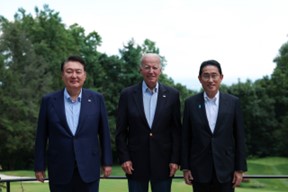
Figure 4 South Korean President Yoon Suk Yeol (left) poses for a photo with U.S. President Joe Biden (center) and Japanese Prime Minister Fumio Kishida during a luncheon following a trilateral summit meeting at the Camp David presidential retreat in Maryland. Photo: Yonhap
US-North Korea Relations: Thunder Rolls
Although North Korea continued re-opening post-COVID, none of that change has redounded to the benefit of Washington-Pyongyang ties. Instead, the lack of contact and mutual recriminations that have defined the Biden administration’s relations with North Korea continued in the final reporting period of 2023, but with a new emphasis: namely, concerns over growing ties between North Korea and Russia. While Pyongyang finds much fault in growing ties between the US, South Korea, and Japan, it has been quite proactive in forging a trilateral of its own with Moscow and Beijing, and evidence of its materiel aid to Russia’s war effort in Ukraine is mounting. This has caused much consternation for the Biden administration. On the one hand, at a time when US support for Ukraine has been stymied by internal political divisions, North Korean arms to Russia are apparently making a meaningful contribution to Russia’s war aims. On the other hand, the US (and South Korea) is worried about what North Korea might be receiving in return (e.g., financial, food, energy, and military assistance of various kinds).
Early in the reporting period, the generally reclusive North Korean leader Kim Jong Un traveled to Moscow for a summit (focusing on both diplomatic and arms cooperation), the first between the two countries in four years. While there, he inspected a factory producing modern fighter jets in Russia’s Far East, and met with Russia’s Defense Minister Sergei Shoigu to inspect Russia’s nuclear-capable bombers. He also extended an invitation to Vladimir Putin to visit North Korea at a time “convenient” for the Russian leader. Putin accepted the offer, though the timing of the visit has not yet been confirmed.
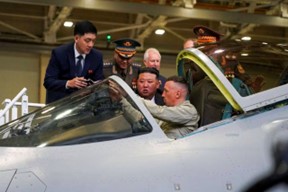
Figure 5 North Korean leader Kim Jong Un visits an aircraft manufacturing plant in the city of Komsomolsk-on-Amur in the Khabarovsk region, Russia. Photo: Governor of Russia’s Khabarovsk Krai Mikhail Degtyarev Telegram Channel via Reuters
The US responded by warning the North that it would “pay a price” for any arms deal with Russia—an ominous but vague threat, one National Security Advisor Jake Sullivan said would take place “in the international community,” as the North had chosen to place itself on the side of a country waging a war of aggression against a neighbor. Days later, the US and South Korea offered a similar warning during a meeting of the Extended Deterrence Strategy and Consultation Group, and noted that such cooperation constitutes a violation of UN Security Council (UNSC) resolutions. They also said they would discuss means of countering their cooperation on Ukraine, as well as how Russia assists the North in its development of nuclear and missile programs.
If Pyongyang was chastened by these warnings it gave no sign, slamming criticism from South Korea as “hysterical.” Indeed, throughout the reporting period reports of cooperation continued to trickle out. In October, CBS reported that North Korea was sending arms to Russia following the Kim-Putin summit. That same month, the Royal United Services Institute reported that Moscow has begun large-scale shipments of ammunition via a new supply route from the North Korean port of Rajin to a Russian military facility on the Dunai, and The Washington Post reported that two Russian ships had made at least five round-trips between North Korea and Russia since mid-August, suggesting that arms transfers could be underway (evidence supports the belief that these transfers have continued). South Korea’s intelligence service in September revealed that Moscow had suggested three-way naval exercises among Russia, North Korea, and China. Later in the reporting period, South Korean officials said North Korea might have provided Russia with short-range ballistic missiles (SRBMs) and portable anti-aircraft missiles, with its military later saying South Korea had detected signs of North Korea supplying ballistic missiles to Russia. Both US and open source intelligence have now confirmed that North Korean ballistic missiles (likely Iskander-clone SRBMs) have been used on the battlefield in Ukraine, a first for these North Korean missiles.
In response, South Korea’s unification minister said that South Korea would consider “powerful” sanctions against Russia, but that these would be implemented in cooperation with the US and its partners, rather than unilaterally.
Such developments might suggest a seismic shift in the relationship between the Korean Peninsula and Russia, which has since the early days of Putin’s rule sought an even-handed approach between the North and South. Whereas the Yeltsin government had shown favoritism toward South Korea and—in Putin’s eyes, at least—lost influence because South Korea no longer had to work for their support and North Korea no longer trusted Moscow, Putin’s government had sought to “stand on two legs” in the Korean Peninsula. Hence it sought to work with both governments, endorsing sanctions on North Korea for its nuclear testing and—as many reports have noted with irony as its cooperation with the North has come to light—supporting bans on weapons trades with the rogue state. Even so, Russia—along with China—came under fire for shielding the North from the most stringent sanctions at the UNSC through its permanent member veto.
Recent interactions suggest the end of that comparative even-handedness, and increasing impunity for North Korea at the UN level. Still, one must note that North Korea has gone more than six years without testing a nuclear device; while that could end at any time, the North may not feel the need to put its partners in the awkward position of choosing between past votes on North Korean nuclear testing and the currently flourishing relationship, at least while aid continues to flow. Kim Jong Un has said that a “forward-looking” and “far-reaching” relationship with Russia will continue. Options for reining in such interactions are limited, which is why—with the US and China seemingly having built a floor for their tumultuous relationship—President Biden has been expressing concern over the North while meeting with Xi Jinping.
Other malfeasance during this time—China’s repatriation of North Koreans (who likely face torture upon their return), Pyongyang’s continued official enshrinement of its nuclear program, the new launch of an ICBM, the unveiling of tactical nuclear attack submarine, suspicious activity involving the long-delayed functioning of a new light-water reactor—is worrisome, but represents mostly developments that have been telegraphed over the last few years.
Another potential watershed during the reporting period revolved around North Korean satellite launches. In late November, after issuing a sudden notice to Japan, the North conducted the launch of a spy satellite, which it had previously defended as an “indispensable strategic option” to counter the United States. Not long after the launch, the North said its spy satellite had taken photos of US military facilities in San Diego and Japan (the quality and use value of which are highly questionable). In addition to ostensible intelligence-gathering purposes of the launch, it has been speculated that Kim Jong Un pushed ahead with the launch because of two failed attempts earlier in 2023, suggesting he worried about signaling weakness. It may also have been an opportunity to put to use the information North Korea has gotten in return for its arms transfers to Moscow; as reported in September, Putin and Kim met at a spaceport and a Russian military plane traveled to the North two weeks later. Also, when South Korea successfully launched its own satellite in early December, the lack of US criticism gave Pyongyang the chance to hit out at Washington’s supposed double-standards.
For now, considering that the North continues to reject the possibility of dialogue with the US, and says it regards the South as an enemy to confront rather than compatriots with whom to reunify (as Kim proclaimed at the end of year KWP party plenum), such activity will continue. The only foreseeable changes to the escalatory cycle would seem to be a change of government in South Korea or the US, or—much as one might not want to contemplate it—a testing miscalculation.
Conclusion: Riders on the Storm in 2024
Looking forward to 2024, South Korean relations with the US are likely to stay on the same trajectory, although there will be new personnel implementing President Yoon’s policies, as the defense minister, foreign minister, trade minister, national security advisor, and chief of the National Intelligence Service were all reshuffled during the final 2023 reporting period. Political conditions may make some policies tougher to enact, as the US (national general elections) and South Korea (National Assembly election) are holding national elections within a highly polarized political spectrum. One new area of US-South Korea cooperation will be at the UNSC, where Seoul will occupy a nonpermanent seat for the next two years (of which one year overlaps with Japan). This will afford the Yoon administration new pathways for pressuring Pyongyang by increasing scrutiny of its sanctions evasion and human rights abuses. A North-South war of words at the UN is highly likely, and one can only hope that fiery rhetoric will not turn into kinetic firing, as Pyongyang has abrogated the entire North-South Comprehensive Military Agreement and the Northern Limit Line buffer zone, opening potential friction points between the North and the US-South Korea alliance.
Much hinges on the upcoming elections. If the South Korean opposition continues to maintain healthy majorities in the National Assembly it will not necessarily change North Korea’s view of the South—the North’s treatment of Moon Jae-in after the 2019 Hanoi fiasco suggests it sees Seoul as little more than a conduit to obtaining sanctions relief via Washington—but it will cast a pall over Yoon’s efforts at trilateralism with the US and Japan and raise hopes for progressives to return to the Blue House in 2027.
There is a US election as well, which will determine if the Biden administration (or another Democratic Party administration) stays in power and will continue (relative to a possible Trump administration redux) a more traditional, risk-averse diplomatic approach. This distinction promises to have a significant long-/medium-term impact on US-North Korea relations, although perhaps not as immediately as one might think: Kim Jong Un surely remembers that Biden’s likely opponent is the one that left him at the altar in Hanoi.
Sept. 7, 2023: South Korean President Yoon Suk Yeol and Chinese Premier Li Qiang meet in Jakarta on the sidelines of ASEAN meetings.
Sept. 8, 2023: A Chinese delegation led by Vice Premier Liu Guozhong visits Pyongyang.
Sept. 9, 2023: President Xi Jinping sends a message to Kim Jong Un marking North Korea’s 75th founding anniversary.
Sept. 23, 2023: President Xi and South Korean Prime Minister Han Duck-soo meet in Hangzhou, where the 19th Asian Games start.
Sept. 24, 2023: Kim sends a response letter to Xi.
Sept. 25, 2023: South Korean Minister of Foreign Affairs Park Jin takes part in the Korea-Japan-China Trilateral Senior Officials’ Meeting.
Sept. 26, 2023: China-South Korea-Japan senior officials’ meeting takes place in Seoul.
Sept. 28, 2023: US solider Travis King is returned from North Korea, with assistance from China.
Oct. 1, 2023: Kim sends a letter to Xi marking China’s seventy-fourth founding anniversary.
Oct. 17, 2023: Activists at the South Korean Foreign Ministry protest China’s repatriation of North Koreans.
Oct. 24, 2023: Chinese Assistant Foreign Minister Nong Rong and a China-South Korea-Japan Trilateral Cooperation Secretariat delegation led by Secretary-General Lee Hee-sup meet in Beijing.
Oct. 25, 2023: North Korea commemorates 73rd anniversary of China’s entry into the Korean War.
Oct. 28, 2023: President Xi sends a reply letter to Kim Jong Un.
Oct. 30, 2023: South Korean Foreign Ministry sends condolence messages to China on the death of Premier Li Keqiang.
Nov. 2, 2023: Xi sends a response letter to Kim.
Nov. 14, 2023: First South Korea-China Economic Cooperation Exchange is held in Changchun.
Nov. 21, 2023: North Korea launches a military spy satellite.
Nov. 22, 2023: Yulin, Shaanxi province hosts 20th Korea Heart to Heart (K2H) Symposium on International Exchanges of Civil Servants for subnational China-South Korea cooperation.
Nov. 23, 2023: South Korea returns the remains of 25 Chinese soldiers killed in the Korean War.
Nov. 26, 2023: Foreign Ministers Wang Yi and Park Jin meet in Busan on the sidelines of the tenth China-South Korea-Japan Foreign Ministers’ Meeting.
Nov. 27, 2023: UN Security Council holds a briefing on North Korea’s satellite launch.
Nov. 30, 2023: South Korea’s National Assembly passes resolution calling on China to stop repatriating North Korean refugees.
Dec. 3, 2023: 16th Tripartite Health Ministers’ Meeting is held in Beijing.
Dec. 4, 2023: South Korean Minister for Trade Dukgeun Ahn and Chinese International Trade Representative Wang Shouwen attend the fifth Korea-China Free Trade Agreement (FTA) Joint Committee meeting held in Beijing.
Dec. 6, 2023: South Korean Deputy Director-General for Northeast Asian Affairs Kang Young-Shin and Chinese Deputy Director-General of the Department of Boundary and Ocean Affairs Yang Renhuo co-chair a Korea-China Deputy Director-Generals’ Meeting on Maritime Affairs in Shanghai.
Dec. 13, 2023: North Korea’s Air Koryo resumes Pyongyang-Shenyang commercial flights.
Dec. 14, 2023: Two Chinese and four Russian military planes enter South Korea’s air defense identification zone without notice.
Dec. 15, 2023: Chinese Vice Foreign Minister Sun Weidong and North Korean Vice Foreign Minister Pak Myong Ho meet in Beijing.
Dec. 18, 2023: North Korea test-fires a Hwasong-18 ICBM.
Dec. 18, 2023: Chinese Foreign Minister Wang Yi and North Korean Vice Foreign Minister Pak meet in Beijing.
Dec. 18, 2023: First South Korea-China Supply Chain Hotline Meeting and the fourth South Korea-China Working-Level Industrial Cooperation Meeting takes place in Seoul.
Dec. 19, 2023: Chinese and South Korean foreign ministries hold director-general consultations in Shenzhen.